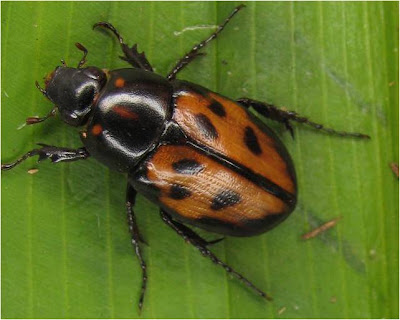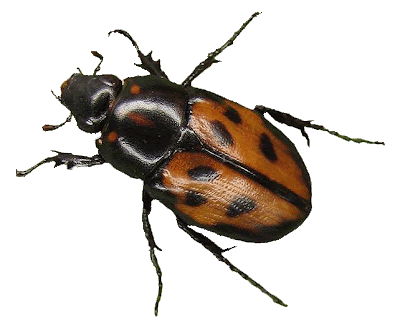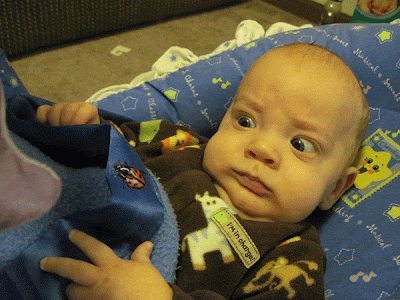Last class we watched the documentary "Flock of Dodos" which showed the contrasting views, arguments, and strategies of evolutionists and intelligent designers.
The film-maker was himself an evolutionist by training and the film was not without its biases. However, he tried very hard to allow the intelligent designers to get their point across and in the end, it was the intelligent design community that would actually appear more appealing to the general public. Intelligent design uses the very catchy and compelling catchphrase "teach the controversy." And why not? If there is a controversy in science it ought to be taught, right? The problem is that intelligent design cannot be tested experimentally and therefore, by very definition, is not science. The evolutionists, however, don't (or at least appear not to) counter with this argument, instead favoring to seemingly attack intelligent design as an outright stupid idea and that anybody who would propose or believe such and idea is likewise stupid.
Evolutionists seemed very confrontational and defensive (neither a strategy that will win many supporters) while intelligent designers often came across as very cooperative and compromising (even admitting that evolution occurs, but saying that some things also clearly point to the hand of a creator). The real downfall of the evolutionists was that they came across as not just attacking the concept of intelligent design as a science, but religion in general. With the vast majority of the general public having faith in some form of God, this strategy will endear yourself to very few.
The evolutionists often used large, complicated words that gave them the appearance of having an "I'm superior to you" attitude, while intelligent designers seemed more like friendly neighbors (although, at times, they did come across as a little too backward and homely).
Finally, the evolutionists came across as being hypocritical at times, recalling the arrest and prosecution of past scientists like Galileo for proposing new scientific ideas and then immediately dismissing intelligent design as ridiculous without a second thought.
Friday, April 9, 2010
Friday, April 2, 2010
Cladogram rendered with Adobe Illustrator
Like photoshop, this is my first experience with Adobe Illustrator. We we supposed to do something with rendering a strat section, but Dr. Parcell suggested that I do something biology related. So, here is my rendering of a cladogram for the tribe Cyclocephalini based off of the unpublished work of Dr. Brett C. Ratcliffe (cerca 1980).


Wednesday, March 31, 2010
Research Topic
For my project I plan to map out the “character states” of each of the 15 genera in the scarab beetle tribe Cyclocephalini (Coleoptera: Scarabaeidae: Dynastinae). This is a crucial step in my Master’s thesis research. To do this, I will need to examine beetles under the microscope and look at many characters (i.e. shape of legs or hair on wing cover) and assign a number to each state that character may exhibit (i.e. 0 for no spines, 1 for one spine, 2 for three spines or 0 for no hair, 1 for short hair, 2 for long hair). This data will be organized, using a program called Mesquite. During the time period remaining, I won’t be able to have a complete analysis, but I should be able to present some of the preliminary work.
Manipulating Images with Photoshop
Our assignment was to take an image and manipulate it in photoshop. I've never used photoshop before, but I think it's an okay first attempt. Since my research is on the tribe Cyclecephalini, I used an image of a species within this group.
Here is the original image of Cyclocephala marginalis:

First I sharpened the image and played around with a few other tweaking features. Then, I cut the image of the beetle out and made the background transparent. Here is the result:

Finally, for fun, I took an image of my son and added the beetle to it. I was trying to make him look apprehensive about it, but it only sort of works as the two images don't seem to blend very well. Still, it was fun.

Here is the original image of Cyclocephala marginalis:

First I sharpened the image and played around with a few other tweaking features. Then, I cut the image of the beetle out and made the background transparent. Here is the result:

Finally, for fun, I took an image of my son and added the beetle to it. I was trying to make him look apprehensive about it, but it only sort of works as the two images don't seem to blend very well. Still, it was fun.

Wednesday, March 3, 2010
Scientific Databases
For class we were to use a scientific database to come up with a scientific research question. Unfortunately, good biological databases lacking at this time. As for as I am aware, there is nothing even close to the level of the geology database, GeoMapApp, we used in class. This lack of biological databases is a problem that my adviser is currently working to solve and is one of the projects I am trying to help with. It's called The Biofinity Project. It will be a repository of biodiversity data and be an invaluable tool to biodiversity research. However, it is not yet available (hopefully within the next couple of months it will be).
Back to the task at hand. The database I did use is called Global Biodiversity Information Facility (GBIF), but it is far from complete in my area of interest. I looked up the distribution data for the beetle Cyclocephala amazona to be suprised by the results. According to my information on C. amazona it occurs from Costa Rica south to Paraguay and Chile (Ratcliffe and Cave 2006), yet GBIF shows records for Panama north to Southern Mexico and even has a record in the U.S. Ratcliffe and Cave said that all specimens labeled C. amazona that they examined from areas north of their distribution turned out to be C. multiplex. All of these GBIF specimens need to be reexamined to determined whether they really are C. Amazona or whether they are the very similar looking C. multiplex.
Therefore:
1) Problem: These data do not conform with the most recent publications regarding species distribution and need to be reexamined.
2) Data available: 817 specimens from the Instituto Nacional de Biodiversidad (Costa Rica), 6 specimens from the University of Kansas Biodiversity Research Center, and 299 specimens from the Texas A&M University Insect Collection.
3) Data limitation: Specimen data from only these three institutions have been submitted to GBIF.
Reference
Ratcliffe, B. C., and R. D. Cave. 2006. The dynastine scarab beetles (Coleoptera: Scarabaeidae) of Honduras, Nicaragua, and El Salvador. Bulletin of the University of Nebraska State Museum 21:1-424.
Back to the task at hand. The database I did use is called Global Biodiversity Information Facility (GBIF), but it is far from complete in my area of interest. I looked up the distribution data for the beetle Cyclocephala amazona to be suprised by the results. According to my information on C. amazona it occurs from Costa Rica south to Paraguay and Chile (Ratcliffe and Cave 2006), yet GBIF shows records for Panama north to Southern Mexico and even has a record in the U.S. Ratcliffe and Cave said that all specimens labeled C. amazona that they examined from areas north of their distribution turned out to be C. multiplex. All of these GBIF specimens need to be reexamined to determined whether they really are C. Amazona or whether they are the very similar looking C. multiplex.
Therefore:
1) Problem: These data do not conform with the most recent publications regarding species distribution and need to be reexamined.
2) Data available: 817 specimens from the Instituto Nacional de Biodiversidad (Costa Rica), 6 specimens from the University of Kansas Biodiversity Research Center, and 299 specimens from the Texas A&M University Insect Collection.
3) Data limitation: Specimen data from only these three institutions have been submitted to GBIF.
Reference
Ratcliffe, B. C., and R. D. Cave. 2006. The dynastine scarab beetles (Coleoptera: Scarabaeidae) of Honduras, Nicaragua, and El Salvador. Bulletin of the University of Nebraska State Museum 21:1-424.
Thursday, February 25, 2010
Tuesday, February 9, 2010
Scientific References
Below are citations to five scientific references that have to do with my research. Following each reference is a little bit about what is found in the paper and why it is relevant to my research.
1. Ahrens, D., M. T. Monaghan, and A. P. Vogler. 2007. DNA-based taxonomy for associating adults and larvae in multi-species assemblages of chafers (Coleoptera: Scarabaeidae). Molecular Phylogenetics and Evolution 44(1):436-449.
This and other similar papers by Dr. Ahrens provide a good look at the use of DNA sequencing in scarab beetles. As I plan to combined morphological and molecular techniques in my phylogenetic analysis, the methods used in this paper will be a very valuable place to look for ideas.
2. Coca-Abia, M. M. 2007. Phylogenetic relationships of the subfamily Melolonthinae (Coleoptera, Scarabaeidae). Insect Syst. Evol. 38:447-472.
This paper contains a morphological phylogenetic analysis of another group of scarab beetles and, like the Ahrens paper above, provides good insights into the methods I should use for my own analysis.
3. Jameson, M. L., B. C. Ratcliffe, and V Maly. 2002. Review of the genus Acrobolbia with remarks on its classification, and a key to the world genera of Cyclocephalini (Coleoptera: Scarabaeidae: Dynastinae). Folia Heyrovskyana 10(1):1-15.
In this paper the genus Acrobolbia is placed in the tribe. Will my research confirm that this is the proper placement? The paper also provides the most recent key to the genera of the tribe.
4. Ratcliffe, B. C. and R. D. Cave. 2009. New species of Cyclocephala Dejean, 1821 from Guatemala. The Coleopterists Bulletin 63(3):325-332.
Two new species of Cyclocephala are described in this paper. It is important because, at least as far as I am aware, it is the most recent taxonomically-based publication relating to the genus Cyclocephala, by far the largest genus in the tribe Cyclocphalini.
5. Smith, A. B. T. 2006. A review of the family-group names for the superfamily Scarabaeoidea (Coleoptera) with corrections to nomenclature and a current classification. p. 144–204. In: M. L. Jameson and B. C. Ratcliffe (editors). Scarabaeoidea in the 21st century: a festschrift honoring Henry F. Howden.
Coleopterists Society Monograph Number 5. 213 p.
Although as its title suggests it is merely a review of the superfamily Scarabaeoidea, this paper is important as it officially places the genus Peltonotus Burmeister, 1847 into the tribe Cyclocephalini. Like Acrobolbia, will my research confirm this placement? Note, however, that this placement comes after the most recent tribe key (Jameson et al. 2002) meaning there currently is no key that includes all 15 genera of the tribe.
----------------------------------------------------------------------------------
Below are 5 more references of interest to my research, but without any descriptions.
1. Jameson, M. L. and K. Wada. 2004. Revision of the genus Peltonotus Burmeister (Coleoptera: Scarabaeidae: Dynastinae) from Southeastern Asia. Zootaxa 502: 1–66.
2. Jameson, M. L. and S. Jakl. 2010. Synopsis of the aroid scarabs in the genus Peltonotus Burmeister (Scarabaeidae, Dynastinae, Cyclocephalini) from Sumatra and description of a new species. ZooKeys 34: 141-152.
3. Joly, L. J. 2000. A new species of Cyclocephala Latreille from the Venezuelan Llanos (Coleoptera: Scarabaeidae: Dynastinae). The Coleopterists Bulletin 54(3):333-338.
4. Ratcliffe, B. C. 1981. New species and distribution records of Surutu from Amazonian Brazil (Coleoptera: Scarabaeidae: Dynastinae). The Coleopterists Bulletin 35(1):107-112.
5. Ratcliffe, B. C. 1992. A new species of Ancognatha from Panama (Coleoptera: Scarabaeidae: Dynastinae). The Coleopterists Bulletin 46(3):256-259.
1. Ahrens, D., M. T. Monaghan, and A. P. Vogler. 2007. DNA-based taxonomy for associating adults and larvae in multi-species assemblages of chafers (Coleoptera: Scarabaeidae). Molecular Phylogenetics and Evolution 44(1):436-449.
This and other similar papers by Dr. Ahrens provide a good look at the use of DNA sequencing in scarab beetles. As I plan to combined morphological and molecular techniques in my phylogenetic analysis, the methods used in this paper will be a very valuable place to look for ideas.
2. Coca-Abia, M. M. 2007. Phylogenetic relationships of the subfamily Melolonthinae (Coleoptera, Scarabaeidae). Insect Syst. Evol. 38:447-472.
This paper contains a morphological phylogenetic analysis of another group of scarab beetles and, like the Ahrens paper above, provides good insights into the methods I should use for my own analysis.
3. Jameson, M. L., B. C. Ratcliffe, and V Maly. 2002. Review of the genus Acrobolbia with remarks on its classification, and a key to the world genera of Cyclocephalini (Coleoptera: Scarabaeidae: Dynastinae). Folia Heyrovskyana 10(1):1-15.
In this paper the genus Acrobolbia is placed in the tribe. Will my research confirm that this is the proper placement? The paper also provides the most recent key to the genera of the tribe.
4. Ratcliffe, B. C. and R. D. Cave. 2009. New species of Cyclocephala Dejean, 1821 from Guatemala. The Coleopterists Bulletin 63(3):325-332.
Two new species of Cyclocephala are described in this paper. It is important because, at least as far as I am aware, it is the most recent taxonomically-based publication relating to the genus Cyclocephala, by far the largest genus in the tribe Cyclocphalini.
5. Smith, A. B. T. 2006. A review of the family-group names for the superfamily Scarabaeoidea (Coleoptera) with corrections to nomenclature and a current classification. p. 144–204. In: M. L. Jameson and B. C. Ratcliffe (editors). Scarabaeoidea in the 21st century: a festschrift honoring Henry F. Howden.
Coleopterists Society Monograph Number 5. 213 p.
Although as its title suggests it is merely a review of the superfamily Scarabaeoidea, this paper is important as it officially places the genus Peltonotus Burmeister, 1847 into the tribe Cyclocephalini. Like Acrobolbia, will my research confirm this placement? Note, however, that this placement comes after the most recent tribe key (Jameson et al. 2002) meaning there currently is no key that includes all 15 genera of the tribe.
----------------------------------------------------------------------------------
Below are 5 more references of interest to my research, but without any descriptions.
1. Jameson, M. L. and K. Wada. 2004. Revision of the genus Peltonotus Burmeister (Coleoptera: Scarabaeidae: Dynastinae) from Southeastern Asia. Zootaxa 502: 1–66.
2. Jameson, M. L. and S. Jakl. 2010. Synopsis of the aroid scarabs in the genus Peltonotus Burmeister (Scarabaeidae, Dynastinae, Cyclocephalini) from Sumatra and description of a new species. ZooKeys 34: 141-152.
3. Joly, L. J. 2000. A new species of Cyclocephala Latreille from the Venezuelan Llanos (Coleoptera: Scarabaeidae: Dynastinae). The Coleopterists Bulletin 54(3):333-338.
4. Ratcliffe, B. C. 1981. New species and distribution records of Surutu from Amazonian Brazil (Coleoptera: Scarabaeidae: Dynastinae). The Coleopterists Bulletin 35(1):107-112.
5. Ratcliffe, B. C. 1992. A new species of Ancognatha from Panama (Coleoptera: Scarabaeidae: Dynastinae). The Coleopterists Bulletin 46(3):256-259.
Tuesday, February 2, 2010
Phylogeny

The tribe Cyclocephalini has never been closely looked at in a phylogenetic way. This image is part of a preliminary, unpublished molecular phylogenetic analysis done by Team Scarab at the University of Nebraska State Museum. They were looking at the family Scarabaeidae as a whole. Here I have cut out the section that includes Cyclocephalines. I don't know how many of you know much about phylogeny, but think of it as a kind of family tree. The closer the branches of two organisms, the more closely they are related, evolutionarily speaking.
On the upper branch, the genera Tomarus, Euetheola, and Oxygrilius are not part of the tribe Cyclocephalini, but as you can see, they are intermixed with several genera that are. The tree as a whole is a mess (see how many places the genus Cyclocephala shows up). That is why there is great need for a closer and more proper phylogenetic study
Thursday, January 28, 2010
Welcome to "Hornless Rhinoceros Beetles"
Dynastinae is a subfamily of scarab beetles known as Rhinoceros beetles. The Dynastine beetles within the tribe Cyclocephalini ("round-head"), however, are characterized by a lack of horns. Thus the origin for the title of this blog. Welcome to the world of taxonomy!
My thesis research project's goals are to sort out the phylogeny (create a family tree) of the tribe Cyclocephalini. This tribe includes 15 genera and a little over 500 species, although new species are being described all the time. All but two of the genera are found in the New World, primarily in the tropics. The two exceptions are Ruteloryctes Arrow, found in Western Africa, and Peltonotus Burmeister, found in Southeastern Asia. The largest genus is Cyclocephala Latreille with about 350 species.
My thesis research project's goals are to sort out the phylogeny (create a family tree) of the tribe Cyclocephalini. This tribe includes 15 genera and a little over 500 species, although new species are being described all the time. All but two of the genera are found in the New World, primarily in the tropics. The two exceptions are Ruteloryctes Arrow, found in Western Africa, and Peltonotus Burmeister, found in Southeastern Asia. The largest genus is Cyclocephala Latreille with about 350 species.
Subscribe to:
Comments (Atom)
